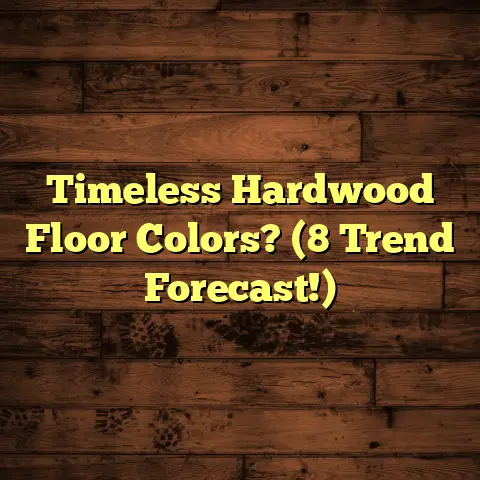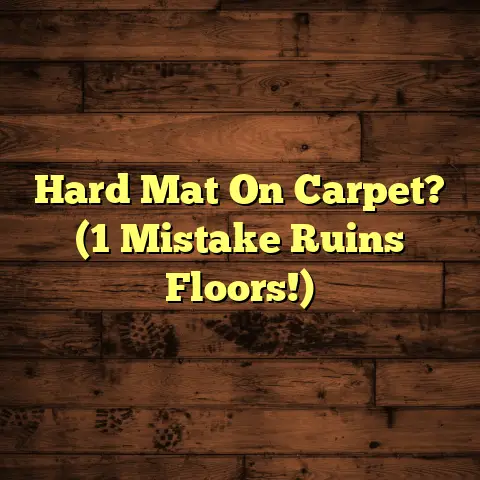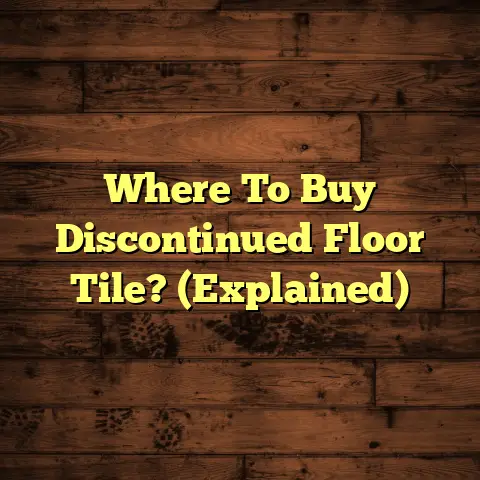Stop Wood Floor Creaks: Pro Tips! (6 Causes)
Introduction: The Soundtrack of Renovation Stories
Every DIY enthusiast has a renovation story that resonates with the trials and triumphs of home improvement.
Picture this: after months of planning, budgeting, and hard work, you finally unveil your newly renovated living space.
The paint is fresh, the furniture is perfectly positioned, and the ambiance is nothing short of magical.
However, as you walk across your beautiful new wood floors, a not-so- pleasant symphony of creaks and groans fills the air.
Suddenly, the charm of your renovation feels overshadowed by the auditory reminders of your home’s age and structural quirks.
Wood floor creaks can be an unexpected and frustrating aspect of home ownership, especially after an arduous renovation project.
Understanding the causes of these annoying noises, however, can empower you to take action and restore peace to your living space.
In this article, we will delve into the six primary causes of wood floor creaks and provide pro tips on how to mitigate these issues effectively.
Trust me, I’ve been there, done that, and bought the t-shirt when it comes to dealing with creaky floors.
Let’s get started!
Section 1: The Nature of Wood Floors
Let’s talk wood, shall we? Wood flooring, in all its glorious forms – hardwood, engineered, even laminate pretending to be wood – is a fantastic choice.
It’s beautiful, durable, and adds real value to your home. But, it’s also a natural material, and that means it’s going to react to its environment.
Think of it like this: wood is like a sponge. It absorbs moisture from the air when it’s humid and releases it when it’s dry.
This constant expanding and contracting is what we call “dimensional change.”
Now, factor in the way most wood floors are installed – nailed, glued, or floated – and you’ve got a recipe for potential movement and, you guessed it, creaks.
Typical installation methods include:
-
Nailing/Stapling: Common for solid hardwood, where planks are directly fastened to the subfloor.
-
Gluing: Often used for engineered wood, providing a stable bond to the subfloor.
-
Floating: Allows the floor to move as a unit, often used with underlayment for cushioning and sound reduction.
Why is wood so susceptible to creaking? Well, it’s all about friction.
As the wood expands and contracts, it rubs against the subfloor, the fasteners, or even adjacent planks.
This rubbing creates those annoying creaking sounds. According to the National Wood Flooring Association (NWFA), proper acclimation and installation are crucial to minimize these issues. https://www.nwfa.org/
It’s not a flaw in the wood itself, but rather a consequence of its natural behavior combined with environmental factors and installation techniques.
Section 2: Understanding the Causes of Creaks
Alright, let’s get down to the nitty-gritty. Why is your floor singing the creaky blues? Here are the six main culprits:
-
Improper Installation
This is a big one, folks. I’ve seen some real horror shows when it comes to installations.
If your floor wasn’t installed correctly from the get-go, you’re setting yourself up for creaks down the road.
Inadequate fastening is a prime example. If the installer didn’t use enough nails or screws, or if they weren’t properly spaced, the planks won’t be held securely in place.
This allows them to move and rub against each other or the subfloor, creating those unwanted noises.
Also, many installers skip the acclimation step. What is acclimation?
Wood needs to adjust to the humidity levels in your home before it’s installed.
If you install wood that’s too wet or too dry, it’s going to shrink or expand after installation, leading to gaps, buckling, and – you guessed it – creaks.
Manufacturer guidelines are there for a reason! They specify the proper acclimation period and installation techniques for their products.
Ignoring these guidelines is a recipe for disaster.
I always tell my clients, “Measure twice, cut once, and acclimate, acclimate, acclimate!” 2. Subfloor Issues
Think of your subfloor as the foundation of your wood floor. If the foundation is weak or unstable, the floor on top is going to suffer.
Uneven surfaces are a major cause of creaks. If the subfloor isn’t perfectly level, the wood planks will flex and move as you walk on them.
This flexing creates friction and, you guessed it, creaking.
Moisture damage to the subfloor is another big problem. Water can weaken the wood, causing it to warp and rot.
This not only makes the subfloor unstable but can also damage the wood flooring itself.
And don’t forget about age-related deterioration. Over time, subfloors can simply wear down and become less stable.
This is especially common in older homes.
I always recommend a thorough inspection of the subfloor before installing any new flooring.
It’s worth the extra effort to ensure a solid foundation for your beautiful new floors. 3. Moisture and Humidity Fluctuations
Remember how I said wood is like a sponge? Well, that’s especially important when it comes to moisture and humidity.
Wood expands when it absorbs moisture and contracts when it dries out.
These fluctuations in humidity can cause gaps to form between the planks.
When you walk on the floor, these planks rub against each other, creating those annoying creaks.
According to the U.S. Environmental Protection Agency (EPA), maintaining a relative humidity level between 30-50% is ideal for most homes. https://www.epa.gov/
I always recommend using a humidifier during the dry winter months and a dehumidifier during the humid summer months to maintain optimal humidity levels.
A hygrometer is a handy tool for monitoring the humidity in your home. They’re relatively inexpensive and can save you a lot of headaches down the road. 4. Aging and Wear
Like all things, wood floors age. Over time, the wood can settle, dry out, and wear down.
This natural aging process can lead to creaks as the material loses its original integrity.
Signs of wear to look for include:
-
Surface scratches and dents: These are normal wear and tear, but they can indicate the wood is becoming more brittle.
-
Gaps between planks: As the wood dries out, gaps can form, leading to movement and noise.
-
Cupping or crowning: This is when the edges of the planks are higher or lower than the center, indicating moisture issues.
-
Loose or broken fasteners: Over time, nails and screws can loosen or break, allowing the planks to move.
Regular maintenance, like cleaning and re-finishing, can help extend the life of your wood floors.
But eventually, even the best-maintained floors will show their age. 5. Insufficient Support
Think of your floor joists as the bones of your floor. They provide the support that keeps everything stable.
If the joists are sagging, spaced too far apart, or otherwise inadequate, the floor will flex and move as you walk on it.
This flexing creates stress on the wood planks and fasteners, leading to creaks.
Building codes specify the proper spacing for floor joists based on the span and the type of wood used.
I’ve seen cases where homeowners tried to save money by using undersized joists or spacing them too far apart.
This is a major mistake that can lead to serious structural problems down the road.
If you suspect your floor joists are inadequate, consult a structural engineer.
They can assess the situation and recommend the appropriate repairs or reinforcements. 6. Fastener Issues
We’ve touched on this a bit already, but it’s worth emphasizing. Fasteners – nails, screws, staples – are what hold your wood floor in place.
If they’re loose, worn, or broken, the planks won’t be held securely, and you’ll get creaks.
Over time, fasteners can loosen due to vibration, moisture changes, or simply wear and tear.
Sometimes, the fasteners themselves are the problem. Using the wrong type of fastener for the wood or subfloor can lead to premature failure.
I always recommend using high-quality fasteners specifically designed for wood flooring.
It’s a small investment that can make a big difference in the long run.
-
Section 3: Pro Tips for Stopping Wood Floor Creaks
Okay, now for the good stuff! You know why your floor is creaking, but what can you do about it? Here are some pro tips for addressing each of the identified causes:
-
Improper Installation:
-
If the floor is newly installed: Contact the installer and demand they fix the issues. A reputable installer will stand behind their work.
-
If the installation was a DIY job: Carefully inspect the floor for obvious signs of improper installation, like uneven plank spacing or loose fasteners.
-
For minor issues: You may be able to fix them yourself by adding additional fasteners or shimming uneven areas.
-
For major problems: It’s best to call in a professional. Sometimes, the only solution is to remove and reinstall the floor properly.
-
Subfloor Issues:
-
Identify the source of the problem: Is the subfloor uneven, damaged by moisture, or simply old and worn out?
-
For minor unevenness: You can use a self-leveling compound to create a smooth surface.
-
For moisture damage: Repair any leaks and allow the subfloor to dry completely before making repairs.
-
For severe damage or age-related deterioration: The subfloor may need to be replaced entirely.
This is a major undertaking, so it’s best to consult a professional. * Moisture and Humidity Fluctuations:
-
Maintain optimal humidity levels: Use a humidifier during the dry winter months and a dehumidifier during the humid summer months.
-
Seal any cracks or gaps: This will help prevent moisture from getting under the floor.
-
Improve ventilation: Ensure proper ventilation in your home, especially in areas prone to moisture, like bathrooms and kitchens.
-
Consider a vapor barrier: If you’re installing a new floor, a vapor barrier can help prevent moisture from migrating from the subfloor to the wood flooring.
-
Aging and Wear:
-
Regular cleaning and maintenance: Sweep or vacuum regularly to remove dirt and debris.
-
Use appropriate cleaning products: Avoid harsh chemicals that can damage the finish.
-
Re-finish the floor: This can help restore the wood’s original luster and protect it from further wear.
-
Replace worn planks: If individual planks are severely damaged, they can be replaced.
-
Insufficient Support:
-
Inspect the floor joists: Look for signs of sagging, rot, or damage.
-
Reinforce sagging joists: This can be done by adding additional joists or sistering new joists to the existing ones.
-
Add support posts: If the span between joists is too long, support posts can be added to provide additional support.
-
Consult a structural engineer: If you’re unsure about the integrity of your floor joists, it’s best to consult a professional.
-
Fastener Issues:
-
Locate the source of the creak: Walk around the floor and try to isolate the area where the creaking is most pronounced.
-
Add additional fasteners: Use a nail gun or drill to add additional nails or screws to the loose planks.
-
Replace worn fasteners: If the existing fasteners are damaged or worn out, replace them with new ones.
-
Use longer fasteners: In some cases, using longer fasteners can provide a more secure hold.
-
Important Safety Tip: Always wear safety glasses and gloves when working with power tools. And be sure to turn off the power to any electrical circuits before working on your floor.
Conclusion: Embracing the Journey of Home Renovation
Renovation is a journey, not a destination. There will be bumps along the road, unexpected challenges, and maybe even a few creaks and groans along the way.
But that’s okay! It’s all part of the process.
By understanding the causes of wood floor creaks and taking the appropriate steps to address them, you can ensure that your renovation story has a happy ending.
So, embrace the journey, learn from the challenges, and enjoy your beautifully renovated home – creak-free!





